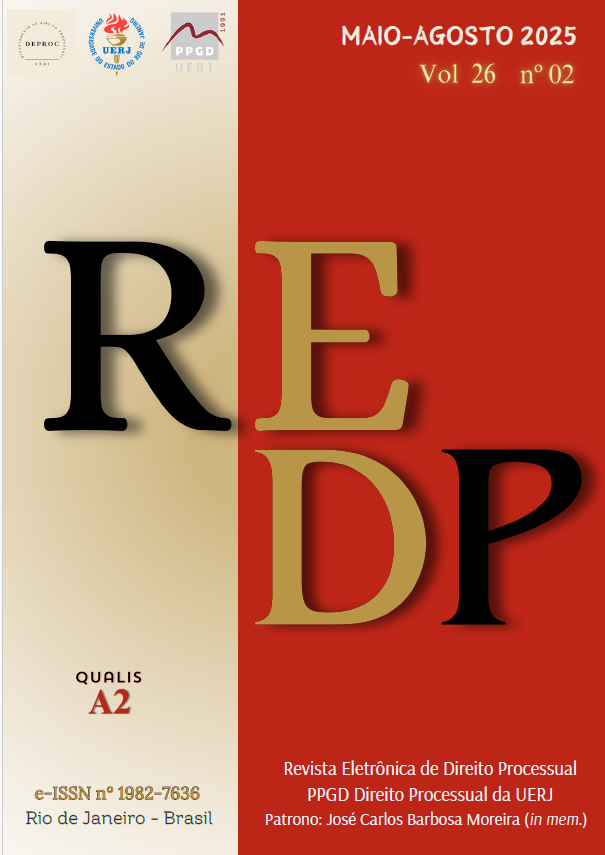BOA-FÉ PROCESSUAL E ABUSO DO DIREITO DE AÇÃO: O ASSÉDIO PROCESSUAL DEFINIDO PELO SUPERIOR TRIBUNAL DE JUSTIÇA E OUTRAS MODALIDADES ESTRANGEIRAS DE ILÍCITO PROCESSUAL
DOI:
https://doi.org/10.12957/redp.2025.91581Resumo
O vigente Código de Processo Civil, ao idealizar um modelo processual pautado no princípio da cooperação processual (art. 6º) e na amplitude da garantia fundamental do contraditório (arts. 7º e 9º) – inclusive como garantia de não-surpresa (art. 10) –, consagra a boa-fé processual como uma das normas fundamentais do processo civil brasileiro (art. 5º), cuja observância é obrigatória por todos aqueles que de qualquer forma participam do processo. Partindo dessa premissa, o presente artigo tem como objetivo analisar diversas modalidades de proteção da boa-fé processual, a partir da vedação de comportamentos abusivos quanto ao exercício do direito de ação. Para tanto, examinou-se, primeiramente, o assédio processual, expressão cunhada pelo Superior Tribunal de Justiça para retratar o ilícito processual consistente no ajuizamento sucessivo de ações judiciais desprovidas de fundamentação idônea e propostas com objetivo doloso. Em seguida, foram analisadas as seguintes situações de tutela da boa-fé processual regulamentadas em ordenamentos jurídicos estrangeiros: a) proibição da sham litigation (em tradução livre, litigância vergonhosa, ou simulada, ou fingida, ou falsa); b) proibição da frivolous litigation (em tradução livre, litigância frívola ou litigância leviana); c) proibição da vexatious litigation (em tradução livre, litigância vexatória); d) proibição da splitting of causes of action (em tradução livre, fracionamento de causas de pedir) e do flood or bury in documents (em tradução livre, inundar ou enterrar documentos); e) strategic lawsuit against public participation (em tradução livre, processo judicial estratégico contra a participação pública) e chilling effect (em tradução livre, efeito de esfriar ou abafar); f) táticas de guerrilha na arbitragem internacional. Ao final, concluiu-se que é necessário continuar buscando a identificação de condutas processuais abusivas, com o escopo de estruturar um sistema jurídico brasileiro de contenção de ilícitos processuais envolvendo as diversas formas de proteção da boa-fé processual e de impedimento ao exercício abusivo do direito de ação.
Downloads
Publicado
Como Citar
Edição
Seção
Licença
Copyright (c) 2025 Marcelo Veiga Franco, Guilherme Costa Leroy

Este trabalho está licenciado sob uma licença Creative Commons Attribution 4.0 International License.
Todos os artigos publicados na Revista Eletrônica de Direito Processual (REDP) (Departamento de Direito Processual, Universidade do Estado do Rio de Janeiro, Brasil) são licenciados por meio de uma Licença Creative Commons - Atribuição 4.0 Internacional (CC BY 4.0).
Os autores retêm os direitos autorais de seu artigo e concordam em licenciar seu trabalho com a licença CC BY 4.0, aceitando assim os termos e condições específicos desta licença disponíveis no seguinte website: https://creativecommons.org/licenses/by/4.0/legalcode.
- Os autores concedem à REDP o direito de primeira publicação, de se identificar como publicadora original do trabalho e concedem à revista uma licença de direitos não exclusivos para utilizar o trabalho das seguintes formas: Reproduzir, vender e distribuir cópias eletrônicas ou impressas do manuscrito como um todo, de partes específicas do manuscrito e de suas traduções para qualquer idioma;
- O uso do artigo por terceiros é livre, contanto que a integridade da publicação seja mantida e seus autores originais, periódico de primeira publicação e detalhes de citação sejam identificados.
Dentro dos termos da licença, os autores podem entrar em acordos contratuais adicionais separados para a distribuição não exclusiva da versão publicada do trabalho na revista.
Copyright and Licensing
All articles published in the Procedural Law Electronic Review (REDP) (Department of Procedural Law, State University of Rio de Janeiro, Brazil) are licensed under a Creative Commons License - Attribution 4.0 International (CC BY 4.0).
- Authors retain copyright to their article and agree to license their work under the CC BY 4.0 license, thereby accepting the specific terms and conditions of this license available at the following website: https://creativecommons.org/licenses/by/4.0/ legal code.
- Authors grant REDP the right of first publication, to identify itself as the original publisher of the work, and grant the journal a non-exclusive license to use the work in the following ways: Reproduce, sell and distribute electronic or printed copies of the manuscript as a whole, of specific parts of the manuscript and its translations into any language;
- Use of the article by third parties is free, as long as the integrity of the publication is maintained and its original authors, first publication journal, and citation details are identified.
Within the terms of the license, authors may enter into separate additional contractual agreements for the non-exclusive distribution of the published version of the work in the journal.




